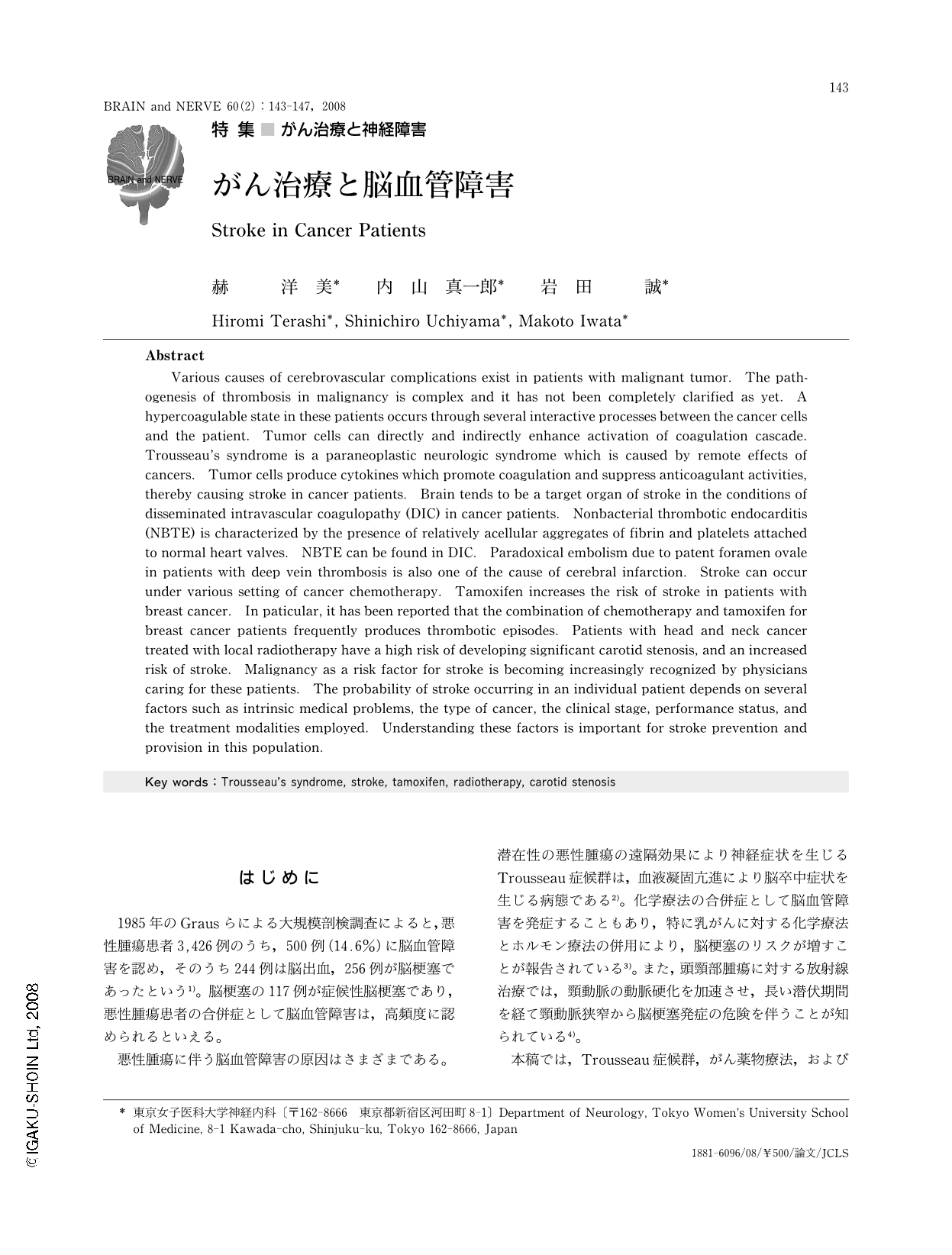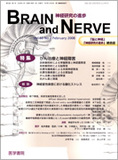Japanese
English
- 有料閲覧
- Abstract 文献概要
- 1ページ目 Look Inside
- 参考文献 Reference
はじめに
1985年のGrausらによる大規模剖検調査によると,悪性腫瘍患者3,426例のうち,500例(14.6%)に脳血管障害を認め,そのうち244例は脳出血,256例が脳梗塞であったという1)。脳梗塞の117例が症候性脳梗塞であり,悪性腫瘍患者の合併症として脳血管障害は,高頻度に認められるといえる。
悪性腫瘍に伴う脳血管障害の原因はさまざまである。潜在性の悪性腫瘍の遠隔効果により神経症状を生じるTrousseau症候群は,血液凝固亢進により脳卒中症状を生じる病態である2)。化学療法の合併症として脳血管障害を発症することもあり,特に乳がんに対する化学療法とホルモン療法の併用により,脳梗塞のリスクが増すことが報告されている3)。また,頭頸部腫瘍に対する放射線治療では,頸動脈の動脈硬化を加速させ,長い潜伏期間を経て頸動脈狭窄から脳梗塞発症の危険を伴うことが知られている4)。
本稿では,Trousseau症候群,がん薬物療法,および放射線治療と脳血管障害を中心に述べることとする。
Abstract
Various causes of cerebrovascular complications exist in patients with malignant tumor. The pathogenesis of thrombosis in malignancy is complex and it has not been completely clarified as yet. A hypercoagulable state in these patients occurs through several interactive processes between the cancer cells and the patient. Tumor cells can directly and indirectly enhance activation of coagulation cascade. Trousseau's syndrome is a paraneoplastic neurologic syndrome which is caused by remote effects of cancers. Tumor cells produce cytokines which promote coagulation and suppress anticoagulant activities, thereby causing stroke in cancer patients. Brain tends to be a target organ of stroke in the conditions of disseminated intravascular coagulopathy (DIC) in cancer patients. Nonbacterial thrombotic endocarditis (NBTE) is characterized by the presence of relatively acellular aggregates of fibrin and platelets attached to normal heart valves. NBTE can be found in DIC. Paradoxical embolism due to patent foramen ovale in patients with deep vein thrombosis is also one of the cause of cerebral infarction. Stroke can occur under various setting of cancer chemotherapy. Tamoxifen increases the risk of stroke in patients with breast cancer. In paticular, it has been reported that the combination of chemotherapy and tamoxifen for breast cancer patients frequently produces thrombotic episodes. Patients with head and neck cancer treated with local radiotherapy have a high risk of developing significant carotid stenosis, and an increased risk of stroke. Malignancy as a risk factor for stroke is becoming increasingly recognized by physicians caring for these patients. The probability of stroke occurring in an individual patient depends on several factors such as intrinsic medical problems, the type of cancer, the clinical stage, performance status, and the treatment modalities employed. Understanding these factors is important for stroke prevention and provision in this population.

Copyright © 2008, Igaku-Shoin Ltd. All rights reserved.


